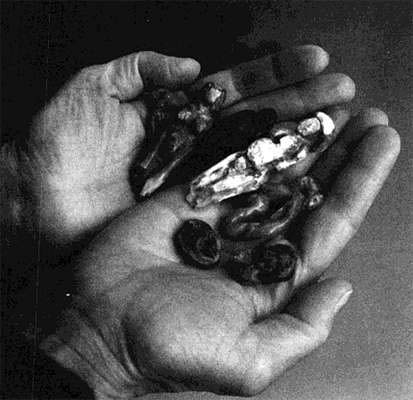It is about no. 7 statuettes out of a total of 15, found during the excavations of the Balzi Rossi complex, dated to the Paleolithic. The Balzi Rossi complex, from the moment it was discovered in the second half of the 800th century, made headlines as one of the most representative monuments of the history of man in Europe, both for the numerous testimonies offered and for the significance of the finds : the site, a high cliff 100 meters long made up of dolomitic limestone full of iron minerals, was inhabited from about 230.000 to 10.000 years ago. Below is the description of the 7 figurines found in Canada.
La Double figurine, or "Beauty and the Beast" (indicated by White and Bisson, those who in 1998 represented the 14 statuettes in a single painting, with the number 01), found in the Grotta del Principe, was carved on a fragment of highly polished greenish-yellow serpentine, 47 mm high, 23 mm thick. and wide at the point of the breast 10 mm.; the weight is about 12 grams. Two bodies are represented, back to back, arranged symmetrically in an arc with an empty space between the heads, suggesting their use as a pendant. One body has the characteristics of the Paleolithic "Venus" with tapered legs and separated by a furrow while the other has been identified as the body of an animal. The details of the upper limbs are completely missing and on the head of the female body there are thin incisions to represent the hair or the headdress, while the features of the face have been deliberately removed by chiselling; a small oval under the neck indicates a probable ornament (necklace). The breasts hang downwards, a small depression indicates the navel and the pubic triangle is rendered in detail with a vertical incision to represent the vulva. The animal's body, on the other hand, has a detailed head with a long snout, large mouth and triangular ears, while the body is so stylized that the identification has remained unsolved: probably a canid (fox or wolf) or a mustelid (marten or badger) but certainly a small carnivorous animal. This statuette, which was found in the Grotta del Principe, is dated to the Upper Paleolithic, is in an excellent state of conservation, except for a fragment which in ancient times detached from the side of the left breast, perhaps during processing.
La Two-headed (indicated by the number 03) is a small female figure with two heads joined together by an arched hole which allows its probable use as a pendant. The heads are ovoid but there is no sign to define the facial features, only a few incisions probably represent the hair; the bust is narrow, without upper limbs, with two prominent conical breasts, a hole marks the navel while the vulva is indicated by a vertical incision. The rather compact lower limbs are separated by a deep incision on both sides; the back is marked by a vertical incision probably to indicate the vertebral column and culminates in a horizontal incision in correspondence with the buttocks. It is the smallest of the figurines in the entire collection, measuring 27x12x8 mm., weighing just under 2 grams, made of translucent greenish-yellow steatite and retaining traces of red ocher visible in the incisions; found in the Grotta del Principe, its conservation conditions are good, even if there is a recent fracture, probably caused during the excavation and then recomposed.
La brown ivory figurine or the "Abrachiale" (indicated with the number 06), so called because of the total lack of upper limbs, is a female figure with a cylindrical head and rounded face without distinctive features of the face or hair; her nape and neck are defined by a deep furrow that divides her head from her shoulders. Her breasts are hemispherical divided from each other while the prominent belly has an elongated groove to represent the navel; the pubis is not marked like other figurines found on site, but has a deep U-shaped groove with a ripple in the center where the labia minora should be. The buxom buttocks contrast with the belly, the thighs in the front are divided by a furrow while in the back they are compact. The legs are broken at the knee but a particular conformation of the left leg suggests that originally an elongated hole divided the legs and perhaps the feet. The statuette has the maximum dimensions of 68x20x23 mm., for a weight of about 20 grams, made in partially fossilized brown ivory, with a light veil of red ocher; it was found by Jullien on an unknown date about 3 meters deep in the Jardin Abbo, a terraced vineyard located west of the Barma Grande. The state of conservation is mediocre, the face and the breast were glued in ancient times, probably by the same discoverer Jullien, as well as other evident ancient fractures are scattered along the body and mended in a not always appropriate manner.
Il Bust (indicated by the number 08), probably female figurine, represented only by the face up to the height of the chest. Her face is almost flat with the features of the eyes, nose and mouth indicated by small incisions; the circular head is delimited by a contour that suggests hair or a headdress while the upper part is flattened. Her shoulders are missing and the chest is represented by a flattened breast, the other having fractured in the past. Traces of workmanship have led to the hypothesis that the bust is part of a statuette complete with abdomen and legs, with a hole between the breasts, subsequently broken and finally fixed in the upper part which has come down to us. On the back there is a handwritten label, probably placed by Jullien, with the indication “Barma Grande, Menton – Cavalieri”, a precious indication for reconstructing some aspects of Jullien's research. It would seem that Mr. Cavalieri was Jullien's worker, author of the excavation at Barma Grande on behalf of the same. Its state of conservation is fair, even if large parts of the surface have flaked off due to the fragility and softness of the material with which it is made. In 1928 Henry Breuil published some photos of the statuette and some sketches made by Abbot Dupaigne, who at the time lived in Canada, erroneously attributing the discovery in the Caves of the Prince, but the label written by Jullien's hand and the presence of sediments of gray sand found on the surfaces of the statue dispel any doubts on the attribution to the excavation in the Barma Grande. Of the maximum dimensions of 29x17x9 mm. Weighing about 8 grams, it was made from bluish-green chlorite.
La Ocher checkers (indicated by the number 09) is a female statuette in the round, with voluminous hair framing the face which ends in two points behind the shoulders, possibly representing braids; diffuse incisions suggest the presence of wavy hair. Her domed face is completely lacking in distinguishing features; her breasts are small and flat, divided by a through hole, probably because it was used as a pendant. Her arms are modeled only in the upper part, up to the height of the hands and run sideways to the shoulders. Her belly is flat but more protruding than her breasts; below some furrows identify the pubic triangle (the vulva is not represented) from which starts a vertical incision to mark her thighs, the latter fractured at the knee. The buttocks are very protruding. The maximum dimensions are 75x18x22 mm., for a weight of 20 grams, made in ivory following the longitudinal axis of the non-fossilized tusk. Its conditions are very precarious, both for the delicacy of the material and for the exfoliation process which affects a large part of the surface. There are large areas colored red due to the presence of a thick layer of ocher which gave rise to the name of the statuette. Found in the Grotta del Principe, it is dated to 18.000 BC
La Monaco (indicated by the number 10), also known as the flat statuette, because it is shaped and engraved on a flat pebble, is a female statuette whose shape recalls the profile of a nun. Her face is without features, highlighted by some lines to represent the hair or the headdress; her bust is wrapped in a cloak into which her arms also merge while the breasts, navel and pubis are indicated by small incisions. The back of the pebble has light engravings, as if another face were represented. Below her neck is a hole, probably because it was used as a pendant. With maximum dimensions of 44x28xabout 9 mm., weighing 14 grams, it was made of very dark green chlorite and found inside the Barma Grande. Its state of conservation is excellent.
La Mask (the only find not represented by White and Bisson in 1998, since it is not considered a statuette), is a small flat circular pebble, modeled with some through holes to represent almond-shaped eyes and a mouth, decorated on the edge of one side with engravings sunburst. Between the eyes and the mouth, a slight curvature indicates the nose, which is further evident due to the two holes representing the nostrils. Above the eyes, in the central part of the forehead, there is a fourth non-passing hole, with a flat bottom (perhaps because it contained something that has been lost), surrounded by radial incisions perhaps to indicate the hair. The back side is not finished like the front face but there are through holes which therefore also identify a face. The representation is that of a face with a threatening and cruel aspect, almost as if to represent an imaginary figure that has no equal in the finds of the European Paleolithic. Found by Jullien during the excavations at Barma Grande, it has maximum dimensions of 19x23x5 mm. for a weight of about 3 grams; it was made from a two-tone, dark green to yellowish steatite pebble. The state of conservation is excellent.
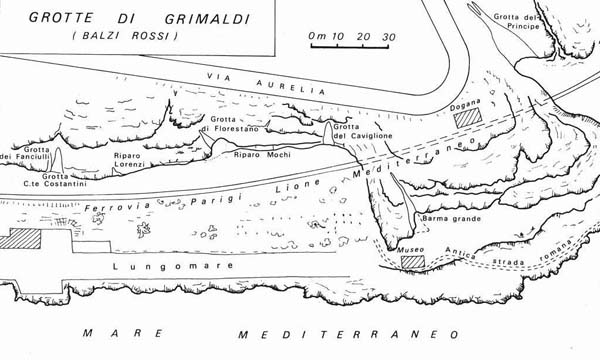
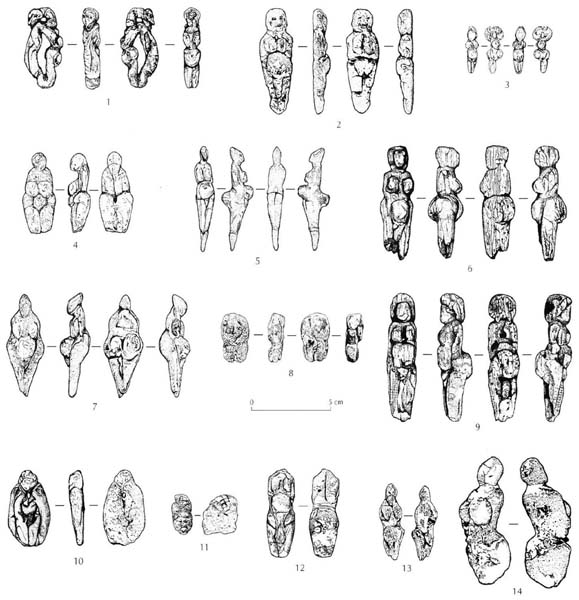

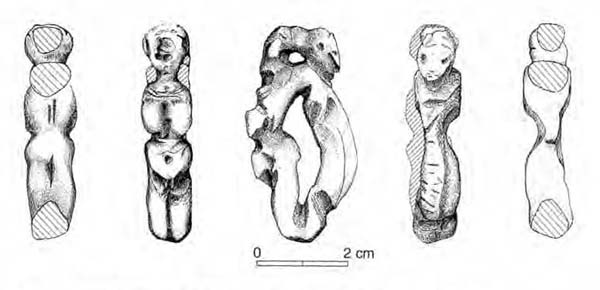
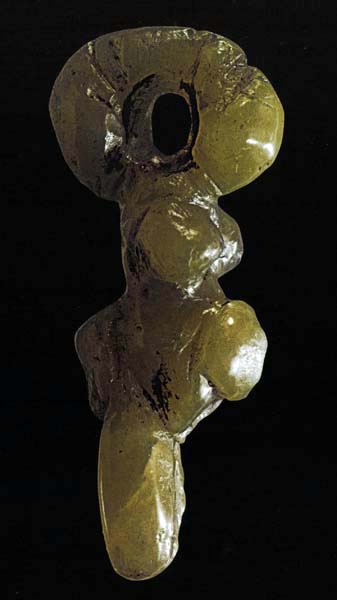

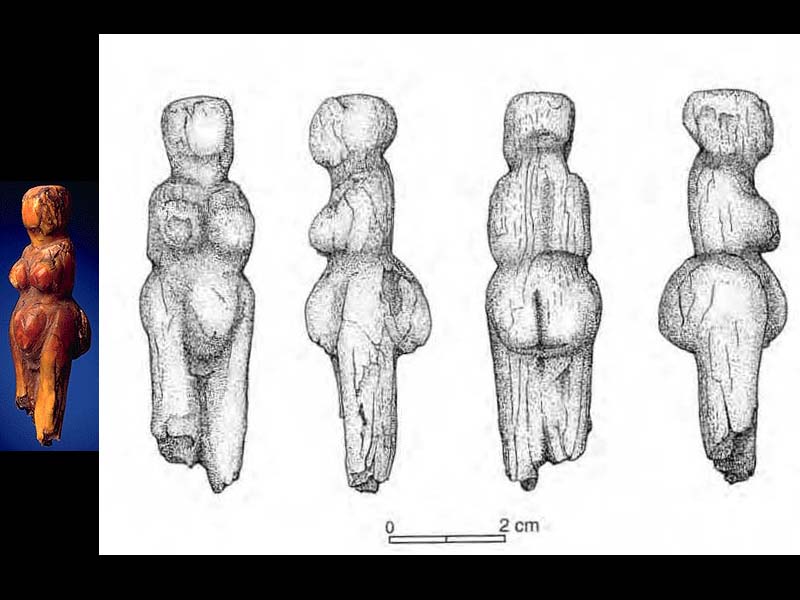
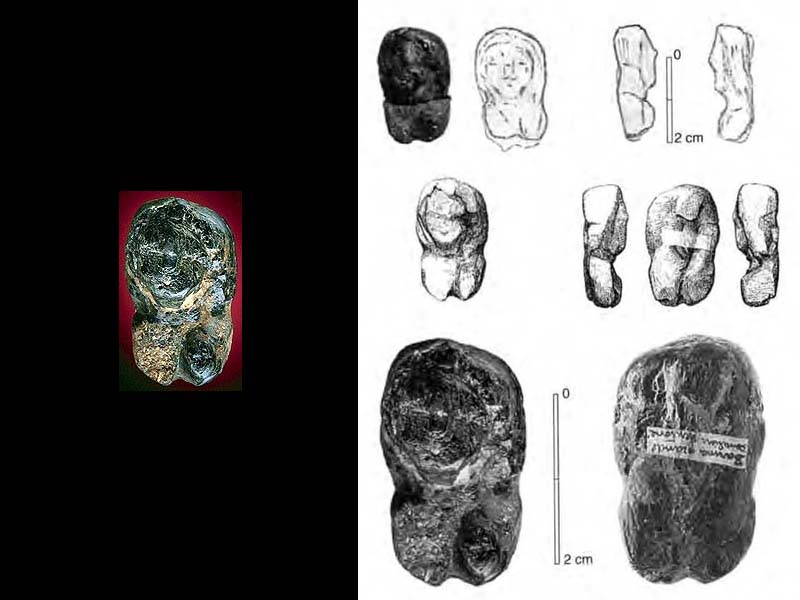

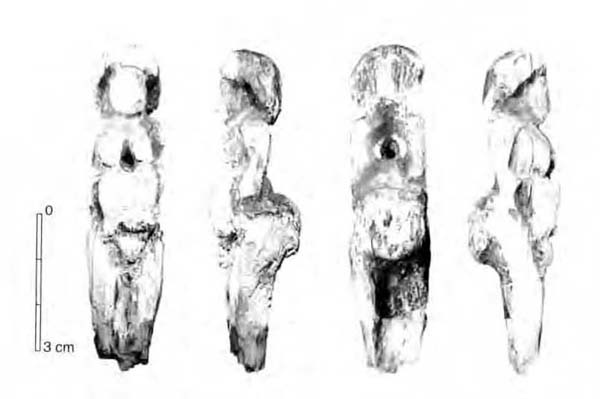
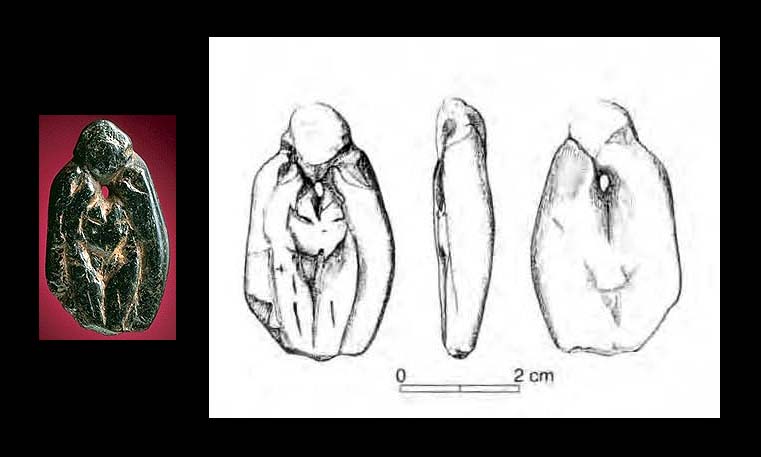
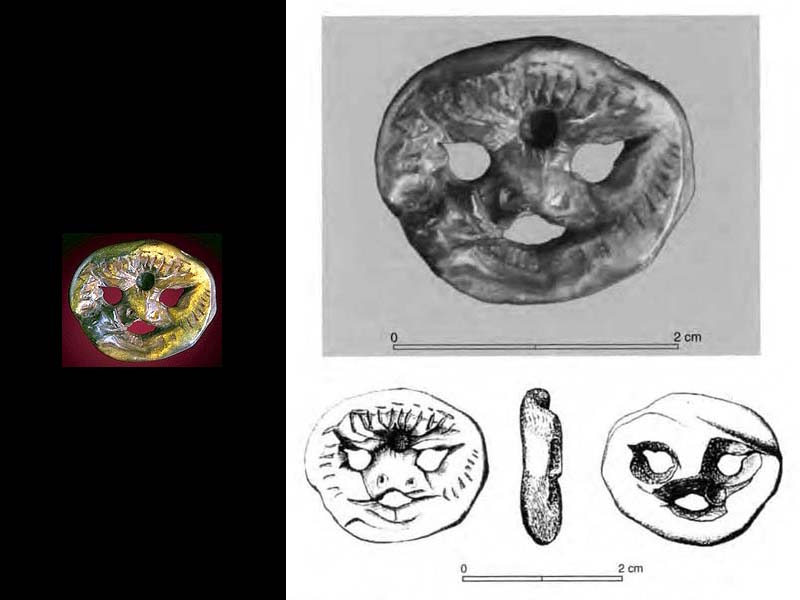
Historical notes
Of the 7 figurines recovered in Canada, only 3 were found by Louis Alexandre Jullien, a merchant from Marseilles, during the clandestine excavations between 1894 and 1895 in the Prince's Cave, which he called the "Cave of the Tunnel" or "Cave of the figurines". ”; the other 4 were found in the Barma Grande during the excavations organized between 1883 and 1884, one in particular in the Jardin Abbo, a terraced vineyard located west of the Barma Grande. Stolen by Jullien and transported to Canada, five statuettes only re-emerged from oblivion in 1987 when Jullien's nieces sold a trunk containing the statuettes to a Montreal antique dealer, which in November of the same year were purchased by a Montreal sculptor, such Pierre Bolduc, for $225. After a few years, in 1993 Bolduc took them to McGill University in Montreal for evaluation and analysis with confirmation that the 5 figurines were indeed the missing part of the long lost Jullien collection. At Bolduc's insistence, Jullien's nieces, Lucie and Laurence Jullien-Lavigne, found the last two figurines, the Bust and the Two-headed.
The historical information concerning the finds is described in the essay "Mothers of Time"and "The Balzi Rossi".
CARD
LATEST PUBLISHED TEXTS
VISIT THE FACTSHEETS BY OBJECT

